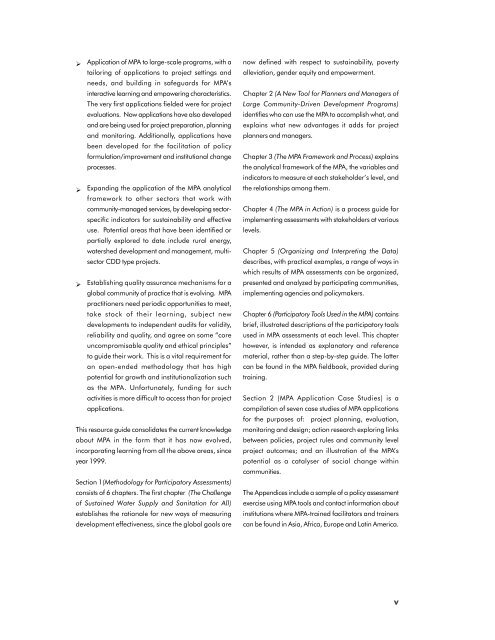Sustainability Planning and Monitoring
Sustainability Planning and Monitoring
Sustainability Planning and Monitoring
- No tags were found...
You also want an ePaper? Increase the reach of your titles
YUMPU automatically turns print PDFs into web optimized ePapers that Google loves.
Application of MPA to large-scale programs, with atailoring of applications to project settings <strong>and</strong>needs, <strong>and</strong> building in safeguards for MPA’sinteractive learning <strong>and</strong> empowering characteristics.The very first applications fielded were for projectevaluations. Now applications have also developed<strong>and</strong> are being used for project preparation, planning<strong>and</strong> monitoring. Additionally, applications havebeen developed for the facilitation of policyformulation/improvement <strong>and</strong> institutional changeprocesses.Exp<strong>and</strong>ing the application of the MPA analyticalframework to other sectors that work withcommunity-managed services, by developing sectorspecificindicators for sustainability <strong>and</strong> effectiveuse. Potential areas that have been identified orpartially explored to date include rural energy,watershed development <strong>and</strong> management, multisectorCDD type projects.Establishing quality assurance mechanisms for aglobal community of practice that is evolving. MPApractitioners need periodic opportunities to meet,take stock of their learning, subject newdevelopments to independent audits for validity,reliability <strong>and</strong> quality, <strong>and</strong> agree on some “coreuncompromisable quality <strong>and</strong> ethical principles”to guide their work. This is a vital requirement foran open-ended methodology that has highpotential for growth <strong>and</strong> institutionalization suchas the MPA. Unfortunately, funding for suchactivities is more difficult to access than for projectapplications.This resource guide consolidates the current knowledgeabout MPA in the form that it has now evolved,incorporating learning from all the above areas, sinceyear 1999.Section 1(Methodology for Participatory Assessments)consists of 6 chapters. The first chapter (The Challengeof Sustained Water Supply <strong>and</strong> Sanitation for All)establishes the rationale for new ways of measuringdevelopment effectiveness, since the global goals arenow defined with respect to sustainability, povertyalleviation, gender equity <strong>and</strong> empowerment.Chapter 2 (A New Tool for Planners <strong>and</strong> Managers ofLarge Community-Driven Development Programs)identifies who can use the MPA to accomplish what, <strong>and</strong>explains what new advantages it adds for projectplanners <strong>and</strong> managers.Chapter 3 (The MPA Framework <strong>and</strong> Process) explainsthe analytical framework of the MPA, the variables <strong>and</strong>indicators to measure at each stakeholder’s level, <strong>and</strong>the relationships among them.Chapter 4 (The MPA in Action) is a process guide forimplementing assessments with stakeholders at variouslevels.Chapter 5 (Organizing <strong>and</strong> Interpreting the Data)describes, with practical examples, a range of ways inwhich results of MPA assessments can be organized,presented <strong>and</strong> analyzed by participating communities,implementing agencies <strong>and</strong> policymakers.Chapter 6 (Participatory Tools Used in the MPA) containsbrief, illustrated descriptions of the participatory toolsused in MPA assessments at each level. This chapterhowever, is intended as explanatory <strong>and</strong> referencematerial, rather than a step-by-step guide. The lattercan be found in the MPA fieldbook, provided duringtraining.Section 2 (MPA Application Case Studies) is acompilation of seven case studies of MPA applicationsfor the purposes of: project planning, evaluation,monitoring <strong>and</strong> design; action research exploring linksbetween policies, project rules <strong>and</strong> community levelproject outcomes; <strong>and</strong> an illustration of the MPA’spotential as a catalyser of social change withincommunities.The Appendices include a sample of a policy assessmentexercise using MPA tools <strong>and</strong> contact information aboutinstitutions where MPA-trained facilitators <strong>and</strong> trainerscan be found in Asia, Africa, Europe <strong>and</strong> Latin America.v
















